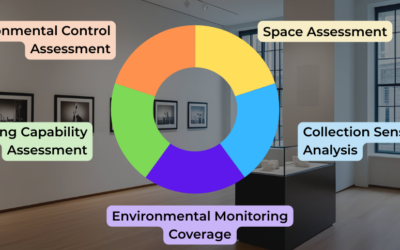Choosing the correct museum lights for paintings is extremely important when it comes to achieving the balance between preserving and showcasing paintings in a museum or gallery setting. Paintings require specific lighting conditions to ensure their visibility, color accuracy, and longevity. Of course, this will depend on the composition of the painting – oil paintings will not be the same as acrylic paintings and paintings on canvas will not be the same as paintings on panels or other materials.
Here are 7 aspects that collections care professionals must take into account when choosing the most appropriate museum lights for paintings:
1) Light Spectrum, Color Rendering and Consistency over Time:
The light spectrum emitted by museum lights can significantly impact the visibility and color accuracy of paintings. Opt for lights that provide a balanced spectrum, closely resembling natural daylight. High Color Rendering Index (CRI) lights, preferably above 90, ensure that colors appear true to the original artwork.
“Product consistency is a very important quality for a lamp that is expected to function for the majority of the next two decades. There is little point in demanding a high set of performance criteria if those criteria are not stable.”
According to the Guidelines for Selecting Solid-State Lighting for Museums, some LEDs can self-regulate temperature “to avoid or reduce the risk of sustained higher temperature operations that will tend to reduce lifespan.” This means that it’s possible for your LED lux readings to vary during the day, although the authors claim small fluctuations are unlikely to be large enough to cause a problem or be noticed by visitors.
2) UV and IR Emission
“Why bother, then, with UV control? Because for many artifacts, such as paintings with permanent pigments or monochromatic prints and drawings, the yellowing and disintegration of the media and support by UV is the major form of deterioration suffered during uncontrolled museum lighting.”
-Guidelines for Selecting Solid-State Lighting for Museums
Ultraviolet (UV) and infrared (IR) radiation are harmful to paintings as they can cause fading, discoloration, and structural damage over time. Select museum lights that emit minimal UV and IR radiation, safeguarding the longevity of the artworks. Go for high-quality LED lights that produce little to no UV or IR radiation. And regardless of what your labels state, make sure you check for UV and IR radiation with a light meter just in case.
3) Illuminance Levels
Maintaining appropriate illuminance levels is crucial for both the visibility of the paintings and their preservation. You should aim for a balance between sufficient light intensity for viewing and minimizing the potential damage caused by excessive exposure. You can use this reference document on light levels for storage and exhibition by the Conservation Center for Art and Historic Artifacts
4) Beam angle and directionality
The beam angle and direction of museum lights play a significant role in the overall lighting effect. When installing lights for the first time, it is advisable to get adjustable fixtures that allow precise control over the beam angle, ensuring uniform illumination across the painting’s surface. Check out this short video on Lighting Techniques from the Smithsonian American Art Museum to see how they use 30 (yes, 30!) different light bulbs in a single small hallway.
Since your painting is likely to be protected by glazing or display cases, make sure you test your lighting angles to avoid annoying reflections. Don’t forget that directional lighting can also accentuate texture and brushwork, enhancing the viewer’s experience.
5) Flicker and dimming capabilities
“Most LED lamps require special dimmers, as those from old lighting systems may not work properly.”
-LED Lighting in Museums and Art Galleries – Technical Bulletin 36
Lights with dimming capabilities will enable you to adjust the light levels for different exhibitions or conservation purposes, but LEDs might have issues with their dimmers that cause them to flicker, which is not ideal. You can get around flickering issues by using different types of screens to reduce intensity – just make sure your screen is not interfering with your color temperatures.
6) Heat output
“In general, if LED lighting is used only to attain museum-level intensities, and this is done without heavy filtering of an overly powerful lamp, then LED lamps can even be used inside cases without causing a temperature rise of more than a degree or two.” LED Lighting in Museums and Art Galleries – Technical Bulletin 36
Excessive heat from museum lighting can accelerate the deterioration of paintings, particularly delicate materials such as paint layers. It can also cause differential expansion between the layers and the substrate, leading to cracking and loss of surface. Opt for lights that produce minimal heat emission, such as LEDs. This helps maintain a stable environment around the artwork, reducing the risk of damage. Once again, don’t trust the labels on your lamps blindly. Use a data logger or a manual spot reader to make sure the temperature inside your cases or around your objects remains acceptable.
7) Energy efficiency and cost
“There are two reasons to pursue a lighting conversion as described here. The first is to save electrical costs and the labor associated with lamp replacement. The second is to achieve energy sustainability goals, which aligns with a museum’s strategic goals for preserving heritage and the environment” Guidelines for Selecting Solid-State Lighting for Museums
Consider the energy efficiency and long-term cost implications when selecting museum lights. LEDs are known for their energy efficiency, consuming significantly less power than traditional lighting options. While the initial investment may be higher, the long lifespan and reduced maintenance needs of LEDs often result in cost savings over time.
Conclusion
A few decades ago, the main driving forces behind choosing the best museum lights for paintings related to the conservation of the paintings and the enjoyment of the visitor. Today, decision makers must also take into account staff availability, overall maintenance costs and environmental sustainability.
By considering factors such as light spectrum, UV and IR emission, illuminance levels, beam angle, flicker, heat output, and energy efficiency, collections care professionals can make the most informed decisions. This will ensure the optimal lighting conditions for both showcasing and protecting paintings in museum settings.
If you have any questions about environmental monitoring, integrated pest management, or just want to talk about preventative conservation, please reach out to us! Don’t forget to check out our blog or join our community of collections care professionals where you can discuss hot topics, connect with your peers or even take a course to get familiar with the Conserv platform.




